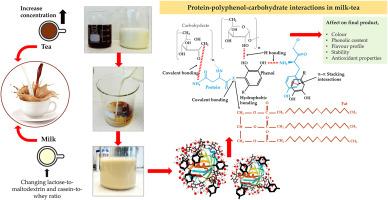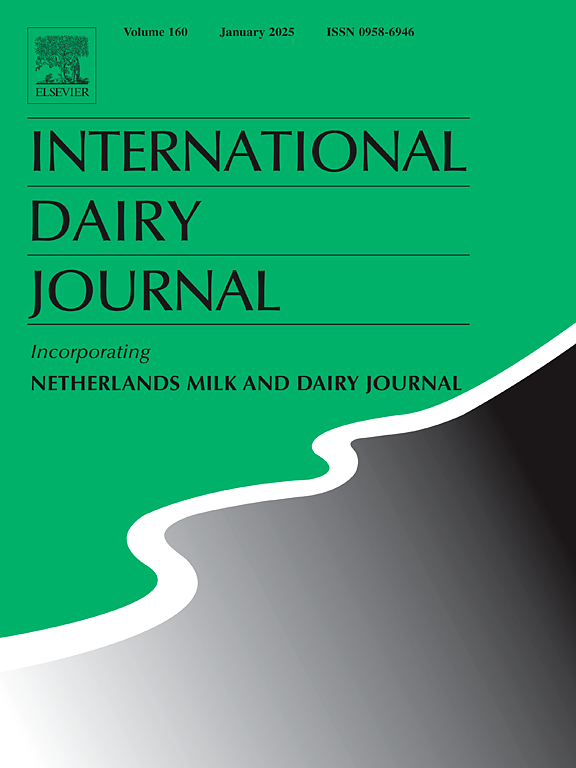成分和茶泡对巴氏灭菌和浓缩奶茶理化性质的影响:关注蛋白质-碳水化合物-脂肪的相互作用
IF 3.4
3区 农林科学
Q2 FOOD SCIENCE & TECHNOLOGY
引用次数: 0
摘要
奶茶因其风味和健康益处而广受欢迎,但其成分对理化性质的影响尚未得到充分研究。本研究考察了不同茶浸泡浓度(1 - 5% w/v)对巴氏灭菌和浓缩奶茶配方的影响。研究了不同的脂肪水平、酪蛋白与乳清的比例(C:W; 80: 20,70: 30,60:40)和乳糖与麦芽糖糊精的比例(L:M; 90: 10,80: 20,75:25)。结果显示,茶的浓度增加了总多酚含量(TPC), 5%的茶在脂肪填充奶茶(FM-T)和脱脂奶茶(SM-T)中都有最高的保留。在FM-T中,脂肪通过疏水性和氢键增强了多酚的稳定性,并且在L:M和C:W比下,在浓缩后,TPC的保留率更高。相比之下,SM-T显示出更强的多酚蛋白结合,导致低L:M比的聚集,尽管麦芽糊精通过水合壳形成帮助保存TPC。总的来说,茶的浓度、脂肪、最佳的C:W和L:M比影响多酚保留率和奶茶的稳定性。本文章由计算机程序翻译,如有差异,请以英文原文为准。

Influence of composition and tea infusion on physicochemical properties of pasteurised and concentrated Milk-Tea: Focus on protein-carbohydrate-fat interactions
Milk-tea is popular for its flavour and health benefits, but the impact of its composition on physicochemical properties is understudied. This study examined the impact of varying tea infusion concentrations (1–5 % w/v) on pasteurised and concentrated milk-tea formulations. It explored different fat levels, casein-to-whey ratios (C:W; 80:20, 70:30, 60:40), and lactose-to-maltodextrin ratios (L:M; 90:10, 80:20, 75:25). Results showed a tea concentration-dependent increase in total polyphenolic content (TPC), with 5 % tea yielding the highest retention in both fat-filled milk-tea (FM-T) and skim milk-tea (SM-T). In FM-T, fat enhanced polyphenol stability via hydrophobic and hydrogen bonding, and allowing for greater retention of TPC after concentration despite L:M and C:W ratios. In contrast, SM-T showed a stronger polyphenol-protein binding, leading to aggregation at low L:M ratios, although maltodextrin helped preserve TPC through a hydration shell formation. Overall, tea concentration, fat, and optimal C:W and L:M ratios influence polyphenol retention and milk-tea stability.
求助全文
通过发布文献求助,成功后即可免费获取论文全文。
去求助
来源期刊

International Dairy Journal
工程技术-食品科技
CiteScore
6.50
自引率
9.70%
发文量
200
审稿时长
49 days
期刊介绍:
The International Dairy Journal publishes significant advancements in dairy science and technology in the form of research articles and critical reviews that are of relevance to the broader international dairy community. Within this scope, research on the science and technology of milk and dairy products and the nutritional and health aspects of dairy foods are included; the journal pays particular attention to applied research and its interface with the dairy industry.
The journal''s coverage includes the following, where directly applicable to dairy science and technology:
• Chemistry and physico-chemical properties of milk constituents
• Microbiology, food safety, enzymology, biotechnology
• Processing and engineering
• Emulsion science, food structure, and texture
• Raw material quality and effect on relevant products
• Flavour and off-flavour development
• Technological functionality and applications of dairy ingredients
• Sensory and consumer sciences
• Nutrition and substantiation of human health implications of milk components or dairy products
International Dairy Journal does not publish papers related to milk production, animal health and other aspects of on-farm milk production unless there is a clear relationship to dairy technology, human health or final product quality.
 求助内容:
求助内容: 应助结果提醒方式:
应助结果提醒方式:


